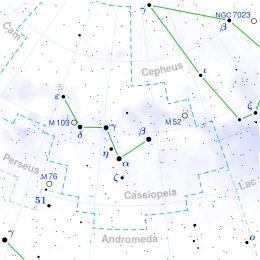Star in the constellation Cassiopeia
HR 511 (also designated V987 Cassiopeiae and Gliese 75 among others) is an orange dwarf of spectral type K0V in the constellation Cassiopeia . With an apparent magnitude of 5.63, it is faintly visible to the naked eye. The star is relatively close, 32.8 light years from the Sun .
This star is estimated to be about the same age as the Sun, with 83% of the mass of the Sun and 82% of the Sun's radius. It has not been identified as a member of any moving star groups . This star has displayed unusual emissions of Ca II and is much more x-ray luminous than the Sun. It is considered a relatively active star. Based on an iron abundance of = −0.02, the metallicity of this star appears to be similar to that of the Sun.
References
^ Brown, A. G. A. ; et al. (Gaia collaboration) (August 2018). "Gaia Data Release 2: Summary of the contents and survey properties" . Astronomy & Astrophysics 616 . A1. arXiv :1804.09365 . Bibcode :2018A&A...616A...1G . doi :10.1051/0004-6361/201833051 .Gaia DR2 record for this source at VizieR .
^ Mermilliod, J.-C. (1986), "Compilation of Eggen's UBV data, transformed to UBV (unpublished)", Catalogue of Eggen's UBV Data. SIMBAD , Bibcode :1986EgUBV........0M
^ White, Russel J.; Gabor, Jared M.; Hillenbrand, Lynne A. (June 2007), "High-Dispersion Optical Spectra of Nearby Stars Younger Than the Sun", The Astronomical Journal , 133 (6): 2524–2536, arXiv :0706.0542 , Bibcode :2007AJ....133.2524W , doi :10.1086/514336 , S2CID 122854
Holmberg, J.; et al. (July 2009), "The Geneva-Copenhagen survey of the solar neighbourhood. III. Improved distances, ages, and kinematics", Astronomy and Astrophysics , 501 (3): 941–947, arXiv :0811.3982 , Bibcode :2009A&A...501..941H , doi :10.1051/0004-6361/200811191 , S2CID 118577511
^ Boyajian, Tabetha S.; et al. (February 2012), "Stellar Diameters and Temperatures. I. Main-sequence A, F, and G Stars", The Astrophysical Journal , 746 (1): 101, arXiv :1112.3316 , Bibcode :2012ApJ...746..101B , doi :10.1088/0004-637X/746/1/101 , S2CID 18993744 . See Table 10.
Demory, B.-O.; et al. (October 2009), "Mass-radius relation of low and very low-mass stars revisited with the VLTI", Astronomy and Astrophysics , 505 (1): 205–215, arXiv :0906.0602 , Bibcode :2009A&A...505..205D , doi :10.1051/0004-6361/200911976 , S2CID 14786643
Kovtyukh, V. V.; et al. (2003), "High precision effective temperatures for 181 F-K dwarfs from line-depth ratios", Astronomy and Astrophysics 411 (3): 559–564, arXiv :astro-ph/0308429 , Bibcode :2003A&A...411..559K , doi :10.1051/0004-6361:20031378 , S2CID 18478960
^ Feltzing, S. ; Gonzalez, G. (2001), "The nature of super-metal-rich stars. Detailed abundance analysis of 8 super-metal-rich star candidates", Astronomy and Astrophysics , 367 (1): 253–265, Bibcode :2001A&A...367..253F , doi :10.1051/0004-6361:20000477
^ Gaidos, E. J.; Henry, G. W.; Henry, S. M. (2000), "Spectroscopy and Photometry of Nearby Young Solar Analogs", The Astronomical Journal , 120 (2): 1006–1013, Bibcode :2000AJ....120.1006G , CiteSeerX 10.1.1.43.4478 , doi :10.1086/301488 , S2CID 16930014
"HR 511" , SIMBAD Centre de données astronomiques de Strasbourg , retrieved 2016-07-09
External links
Categories :
Text is available under the Creative Commons Attribution-ShareAlike License. Additional terms may apply.
**DISCLAIMER** We are not affiliated with Wikipedia, and Cloudflare.
The information presented on this site is for general informational purposes only and does not constitute medical advice.
You should always have a personal consultation with a healthcare professional before making changes to your diet, medication, or exercise routine.
AI helps with the correspondence in our chat.
We participate in an affiliate program. If you buy something through a link, we may earn a commission 💕
↑
